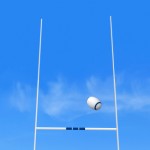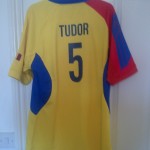 I guess I’m no rugby expert but I am an avid fan — those of you who know me can probably testify for that. My passion for the sport goes to the point of considering rugby the ultimate sport – as I believe it has a bit of every other sport in it – and as such there is a lot to learn from this beautiful sport. And being the ultimate sport I think rugby is, it can teach us things that can be applied in many aspects of life, work, universe and everything.
I guess I’m no rugby expert but I am an avid fan — those of you who know me can probably testify for that. My passion for the sport goes to the point of considering rugby the ultimate sport – as I believe it has a bit of every other sport in it – and as such there is a lot to learn from this beautiful sport. And being the ultimate sport I think rugby is, it can teach us things that can be applied in many aspects of life, work, universe and everything.
With that in mind, I’m going to have a look at my learnings from rugby in terms of building a team — a team you can send on the pitch to win a game, not just provide cannon fodder for the opposition. As I said, I don’t claim to be an expert in rugby, but I have learned a lot about it throughout my years – partly by sitting in front of the TV and watching it, by reading about it, and most importantly by playing it and being involved in an amateur rugby team. That bit in itself proved to be an awesome experience – and while my team mates are probably still laughing about my (historical by now) offside against Stanford, and many other (funny) mishaps of mine, they have taught me a lot – about rugby, about strategy, about team play. Hence my rant here about this.
NOTE: Before you go into this post, I have to point out that I have discovered this by sheer luck — it’s one of the posts that I have written ages ago on the London Underground, on my BlackBerry. And only found out now, upgrading the WordPress app on my phone, that this was saved as a draft there and never published. This proves on one hand how old my phone is 🙂 and also, be warned, it does mean that it is probably a bit out of date in terms of references to rugby teams it makes. I remember at the time I wrote this, RWC 2011 was in full swing and also I remember that this made a very interesting observation exercise for watching and learning how a team works together. I still believe some of these rules apply to any team out there and the overall message should still be valid..
It’s not an easy task putting together a rugby team, let’s make no mistakes about it! That involves picking your players such that they glue as one on the pitch, it involves looking after their development, making sure the weak areas get more attention, it involves developing a strategy which will use your strongest points and much more! And you have to pack all the qualities you need during the game in 15 players!
As a coach you probably start picking your team with the forward pack — they are the ones required to step up when the game restarts, they are the ones required to step up when the opposition is beginning to attack and they are the angels on your backs’ shoulders when your team is attacking and you need that ball to stay in your team’s hands. A crucial part of the forward pack is “the tight 5” — your front rowers and the 2nd row: these are the base of your scrummaging and your main piece for line-outs. You choose your prop forwards wrong and you’ll end up with your scrum collapsing, going backwards or even worse, injuries! If your prop forwards haven’t got that bloodthirsty mentality, if they don’t want to go on the pitch and drive through every single opposition player and smash him into pieces, you are probably looking at the wrong props. You need your props made of steel, able to physically move any mountain — and have it embedded in their mind that they can! It doesn’t matter if they will never be able to put their neck in a scrum and move mount Everest, they need to think they can and don’t hesitate once when confronted with such challenge. (Your centres will know better and never motion one of your props to try to smash Mount Everest, so don’t worry about the absurdity of the above statement for now.) They are also the pillars of your scrum — if your props can’t stand their ground, drive like a bull while supporting your hooker your scrum is lost — and from there on all the opposition has to do is go for scrum every single time for a simple win!
I’ve mentioned the hooker briefly earlier but he deserves more attention: if your hooker doesn’t have the support from the props in the scrum and he doesn’t have the legs and the ability to win you the ball then you might end up pushing the opposition scrum and killing their forwards, but the opposition hooker will still get the ball before yours – and with a quick ball out of the scrum from there on, while you’re killing the opposition forwards, their backs are off with the ball towards your try line! Even more, this guy has to show some precision throwing at line-outs — you can have Victor Matfield in the lineout, yet if your hooker fucks up the ball at lineout you might just as well not bother jumping and let the opposition have the ball.
So already, as you can see — based on only the 1st row, the “team glue” factor is already apparent. If these 3 guys don’t work well together they can ruin all the good work the others are putting in!
Same goes to your seconds — the locks: the props can be as hard-hitting as they come, if your locks are not there to provide the push, to stand their ground when the opposition is attempting to drive you back, you got a messy lost scrum on your hands, and the opposing forwards will just walk (literally!) allover your forwards at each scrum. And every single aspect matters when it comes to these 2: if they don’t bind properly, if they are not as tight as they should be, the scrum can go haywire. If they don’t push at the same time, the scrum can break. If they are not equally powerful, they can cause the scrum to turn and give away penalties (don’t forget that the last RWC was won by the kiwis by one single point only, so every point counts!). If they don’t sync up with the props and the hooker to move together in the scrum then you end up with a scrum going down. They are also a main weapon in your line-outs – but no point in your other forwards throwing them right up in the air if they can’t cover the area and touch the ground back with the ball in their hands. And they can be as good as it comes, but if they don’t sync up with the hooker and the line-out call and the throw, again, you’ve just given the opposition an easy ball.
Ultimately if your “tight 5” are rubbish — you can have the best kickers and runners in the backs, but you still got yourself a recipe for losing a game, very likely: why would the scrum-half spend any time and attention around a scrum or a line-out, when the ball is going to be constantly lost to the opposition? Your centres will find themselves always thinking defensively, trying to save tries rather than scoring them — and that is only cause 1/3 of the team is nonperforming and/or is not linked up properly!
Take the back row now for example — this is part of your attack strategy as well as 1st line of defense. Your flankers must have their shoulder right in there when the scrummage starts, but must be at the first breakdown down right off the scrum: you want your backs ready to get that second ball and fly through the opposition, not having to get involved in scrums that involve mainly their physicality, not their quick thinking and quick step! If your flankers are not present at first breakdown off the scrum, your backs have to get involved; and with each back engaged in a ruck, you lose another offensive weapon — making it more difficult for your team to score. Your flankers MUST be there — they must “read” the hooker, your locks,your number 8 and the half-back and feel pretty much that the ball has been won, it’s with your players, and they will need support any moment now, and as such disengage the scrum and run like a mothertrucker to the next ruck and ensure that ball stays yours! One moment delay from the flankers, one un-sync with the rest of the scrum and the scrum-half and the next ruck might be a turnover! If your locks don’t tell them the ball is at the back of the scrum, if your number 8 — scrum half — fly half channel doesn’t communicate with them properly, they miss the moment to run for support, and you quite likely lose the ball.
Your number 8, next, is in a lot of cases your first weapon in the attack, as normally the attack off the scrum is directed by the number 8 — half-back — fly-half axis. If your scrum goes as planned, your number 8 will have the ball at his feet; he is making the decision, while the forwards are still driving, if it’s time to let the ball loose. Does he run with it and gets the opposition backs to get engaged in a ruck and make holes in their defense? Does he leave it to the scrum-half to pass the ball wide and let the backs loose in attack? Does he tell his forwards there’s more yardage that needs to be made before he does anything with the ball? It’s all down to how well he knows the other fellow forwards and how well he teams up with the half-backs. He picks up the ball and runs alone with no flankers on his shoulder and you force your centres and backs to get involved in rucking breaking down your attack. If he doesn’t get the ball out in time you miss the opportune moment. If he doesn’t let the half-back to direct the next move when needed, you miss an opportunity. And he can be as versed as they come, if your other forwards don’t get him the ball there’s not much he can do.
The scrum half is another key player in your attack axis off the scrum: he has to have the vision whether the ball needs to come out quickly and spin it wide if he sees a hole in the defense and know your backs can make a run for it. He has to know his back and forwards very well such that his decisions to play the ball always gives your team an advantage. If defense is tight, he needs to get your forwards to repeatedly batter the defense line till it cracks. If there’s space on the left then he needs to direct that ball towards your left winger — and know that the rest of the backs and centres will understand that and play the ball accordingly. He needs to be there at every ruck to make these decisions — there’s no point in your players winning and keeping the ball at every ruck if he’s nowhere to be seen. And he can motion the forwards at the ruck to clear the mess and get him the ball — if there’s doubt about whether he can do anything with the ball, your forwards will not jump in to execute, as there’s nothing more frustrating for the forwards than getting out of a physical ruck only to find out your scrummie has fucked up the ball.
As for the fly half, he’s your pivot player for the team — absolutely needs to work with the scrum-half and the number 8 to build the attack together. If the fly-half is screaming for the ball, your scrummie needs to execute just that because this guy has just seen a hole in the defense wall and is building the mechanisms and moves required to exploit that! He needs to be in the best position relative to your scrummie and your other players to get the ball from the scrum yet have enough time to make decisions whether to run it, kick it (be it for goal or to unleash the backs on the opposition) or to open wide your attack. If he’s not a good kicker, your players won’t be that keen on getting the ball out for his kick attempts. If he doesn’t link up well with number 9, scrummie will probably make the decisions for him occasionally and your attacks would go right into the inside centre and you find yourself attacking with a man out of the move — that can still win you a game, but it makes it more difficult on everyone. In defense his support is the fullback, as they do open cover half of the pitch each to catch the high kicks — so apart from the number 8 — scrum-half channel, he needs to develop and maintain a strong link with your fullback too, as well as the wingers, who he might choose to open up via a forward kick if he spots an uncovered area in the opposition defense.
As with the forwards discussion, your fly-half can be Dan Carter, if the rest of the backs are not up for it, all the opposition has to do is just smash him each and every time and you will loose the ball — and ultimately the game. If your half-backs are the tip of the spear, your inside and outside centres are the shaft of it as these guys are the ones who run the ball and execute the maneuver that the fly-half initiated. They need to read the moment when to start the dummy run, when to switch, when to pass or when to punt. They need to read all of your pack as well as the wingers too. They need to be ready to catch the ball at any point, run and offload to either the forwards or the fly-half to allow him to build the attack, or simply just run for the try line on their corridor, when open, safe in the knowledge that if they get shot down, the forwards are right behind them for support.
And behind them, the 2 wingers have to run close enough to provide support for a ruck if needed or get the ball as the centre is drawing opposition players in, opening the way for them. They are quite often the ones to ground the ball: half a meter too much behind the game and they can’t make it over the line, half a meter too close to the ball and they might not get enough momentum to smash the oposition in contact and jump over the line and score the try. Too close to the touchline and they can easily get pushed into touch, losing the ball, too far from the touchline and they get in the centre’s way… as well as being much closer to rucks and therefore much easier to reach and tackle by the opposition.
They are the instruments of the fly-half and centres but have to be in constant dialogue with your full-back who has to constantly position his wings in defense. At the same time, a fullback is a modern weapon of attack — and the wings need to listen to your fullback when he’s getting involved in the attack.
Now, you’ve heard me saying a lot of times “player X needs to listen to player Y” — and hopefully this has underlined another important aspect here: all of these “orders” barked on the pitch have to be synchronized! If you’re fly-half cries for the winger to stay left while your full-back directs them right, you’re doomed. You need to either ensure that the players read each other or such conflicting situations will occur. You need to ensure that someone has authority — and if the fly-half calls for winger to go left, then they execute just that; if the fullback sees a problem with that they need a quick way of signalling this to each other, but ultimately one of them has to call a decision and everyone else needs to stick to that. And that decision has to be good! And when it’s bad, your team has to learn to put up with it, because they know that’s one tiny error margin — they have to trust that the decision making is solid, and see that in the results of these decisions!
To close this post — as I said, most of it was written about a year ago! — I guess I’ll just iterate again that how to build, run and keep a team motivated is something that is not applied to development teams only — and the likes of us, techies, can in fact learn a lot from rugby.







